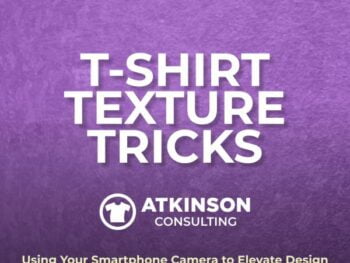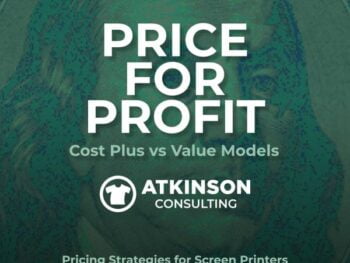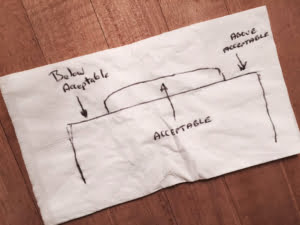Before starting this article, check out our new shop video! Here’s the link: Visual Impressions Shop Video
As part of being named a Top Shop from Stitches magazine for the March 2014 issue, they asked us to submit a short video that illustrates Visual Impressions as a company. Sounds easy, but once you get started it’s a daunting task; especially if you don’t have “movie making skills”. Daryl Cardwell, our talented web master for Ink to the People and I were the main members of our staff selected to build the video. We leaped at the chance to try to learn something new. Soon afterwards, we met and brainstormed, and with some input from Todd Richheimer and Jay Berman, the company’s owners, we put together a game plan. (Also a shout out here to Ross Brandt, a creative and knowledgeable source from Coil Media in Atlanta who gave me some great phone advice during the initial discovery phase)
By the end of the process, we had a great video, learned some valuable lessons and will definitely be doing more shop videos in our future! I’m definitely not Martin Scorsese, but here’s a step by step outline of how we constructed the video, and some tips that might save you from making the same mistakes we made.
- Outline & Basics. Our first thought was “what are we going to film”? We discussed interviewing different staff members, and also filming multiple shots of things happening at Visual Impressions. We also Googled tons of other shop’s videos, non-industry business videos and other sources to see what others had accomplished and give us a basic knowledge base. The basis of every video we liked had some sort of narrative, some action shots of processes being completed, on-screen text to describe things, and an overall theme. We had a series of meetings, and through those narrowed down some key elements that we wanted to discuss. Our core concepts that we would use for the interview portion of the video were decided: Trust, Quality, & Dedication. Tip: Do research. Watch what others have done. Find what you like and take note of it. Think about how it was done.
- Storyboard. I spent some time storyboarding what we wanted to shoot, and working on arranging the sequence of shots. For this I just scribbled out some notes and cartoons of people on individual Post-It-Notes. I stuck these to the back wall in my office across from my desk. From here, I would arrange and rearrange them to see if we could come to some sort of agreement on what we needed, and how it would come together. Our goal was to keep it to a short video, and keeping it simple looked like it was going to be a challenge. This is definitely harder than it looks. Tip: Plan. Storyboard your ideas, and create a solid concept. Don’t just shoot and wing it. Talking about what we wanted to do made the filming much, much easier.
- Equipment. We wanted to do it cheaply, and by cheaply I mean with whatever equipment we had on hand at the time. Other than our time, our budget was $0. Nada. We used our camera phones for some shots, but most of the filming was handled with an existing Nikon camera on a tripod. Comparing shots from the phones vs the normal camera on the tripod, the tripod shots all looked better. Tip: use a tripod if you can. Shots are steadier, and easier to take. If you don’t have a tripod, balance the camera on a box, ledge or something.
- Filming. We decided that we wanted an interview style format. I wrote a series of questions that we would ask different people in the shop. The goal was to unearth authentic sound bites that we would use as transitions into video shots of different production processes in the shop. If you watch the video, I’m off camera (except when I was interviewed by Daryl for my shots), doing this way I think gave the video a conversational feel, and a natural look for us. We interviewed a lot more people than we used for the actual final video. Judicious editing to get the video down to 3:30 was necessary. I’m sure there are actors out there that will tell you their best work is on the cutting room floor too. Tip: Check your memory card and battery life often. We had to reshoot two interviews because our memory card on the camera was full and we didn’t realize it. Also, when something like that happens….chalk it up to rookie mistakes and don’t worry about it. It was actually kind of funny when it happened!
We took some test shots around the building to find a location that would work for sound and lighting. This took an afternoon, as we tested a bunch of locations and then would run back to Daryl’s computer and review them. We chose the couch in our lobby, because it had some great natural light and we liked the casual but modern feel. Tip: Blocking and checking where you want to film before you start helps you understand how the final shots may appear. It may also give you some much needed practice with the equipment (we sure needed it!!).
Overall, we filmed about 120 clips for the video. There is a lot of footage we didn’t use, and Daryl did a great job editing and paring it all down to three and a half minutes. Interviewing people was really fun, but the shots of the production processes were hilarious to make. We had a great time thinking up camera angles and planning shots of things moving to make the video exciting. Some of the shots were planned, but others were just us taking advantage of what was going on at the time. Tip: If you are doing an employee interview style, try to get everyone to say or do something that was the same. At the end of the video, we have all of our people smiling and getting up off the couch. I actually asked everyone to “laugh and say something funny”. At the time, nobody did anything funny and everyone just smiled and got off the couch. It actually turned out to be a good way to end the video. It was pure luck, but prompting an action was the catalyst.
- Lessons Learned. In a nutshell, here are our take-aways…
- Plan. Storyboard your ideas, and create a solid concept. Don’t just shoot and wing it.
- Know your strengths. Do what you know. If you are more suited talking in front of the camera, do it. If you enjoy shooting and editing, do that.
- Daryl imported all of the clips into iPhoto and used iMovie to edit it. These were already on the Mac he had, so we didn’t purchase any special software.
- It only took about a day and half for filming, but over twice that for editing. If you are under any time constraints, make sure you plan accordingly.
- Don’t go overboard on humor, graphics or transitions. It may be tempting to use a spiral cross-dissolve to transition scenes, but remember…less is more. Keep it simple and professional.
- Don’t buy background music. There is a ton of free and well organized clip sites. Just do a Google search.
- We learned that even if you do a sound check, you won’t know the sound levels for each interviewee. After we finished we went out and spent about $10 for a lapel microphone for next time.
- Review your footage several times to see where the good stuff is before starting to edit.
- Check your camera battery and memory card often.
- Take some test footage to get familiar with the equipment, software and different camera angles.
- Don’t use everything you shoot. Shoot a lot and pick the best clips.
- Shoot as high quality as you can. You can always make it smaller when you need to.
Well, that’s about it!! I hope you enjoyed our video and admittedly beginner’s effort. Like the former art director in me says, “Done is better than perfect.” If you do try to tackle this, post your video below and let’s share the experiences so others may benefit! You can also always e-mail me at matkinson4804@gmail.com for more information or help.



3 comments
tee shirt catch wwe
I like the valuable info you provide in your articles.
I will bookmark your weblog and check again here regularly.
I am quite certain I will learn many new stuff right here!
Best of luck for the next!